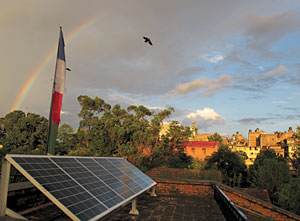 KUNDA DIXIT |
Demand will continue to outstrip supply even if new plants are built in the next three years. Power cuts are here to stay.
Yet, there is one breed of consumer in Nepal who is not worried. It has made the switch to solar and the power cuts don't affect this group at all. Suppliers are rushing to fill the demand for household and office power with more efficient panels, more robust batteries and better relays and switching systems.
For Nepal, solar is the next best thing to hydro. We have plenty of water and plenty of sunshine if hydro is lagging behind, why not harness the sun?
Both are renewable forms of energy and once solar panels are installed they have minimal operating costs and can provide uninterrupted power supply. Nepal falls in a prime solar region, getting two to three times more solar energy than Germany, currently the largest producer of solar electricity in the world. Solar panels are also more efficient in cold climates, like the Nepali winters when there is power shortage but plenty of sunlight.
Read also:
Here comes the sun
The world's 'Solar King' ,
RIC WASSERMAN in STOCKHOLM
China's Huang Ming wins this year's 'alternative Nobel' for being a solar energy pioneer


